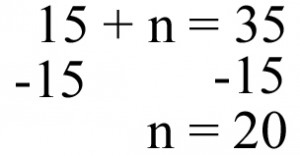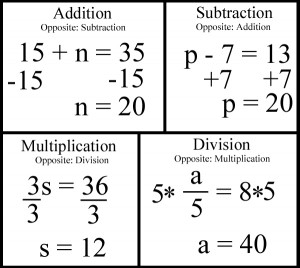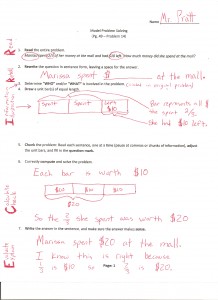Topics:
1. Writing Equations
2. Solving Equations
3. Problem Solving
4. Review/Test
Writing Equations
The idea behind this lesson is to get us a little more familiar with story problems. We need to be able to take the information in the story problem and turn it into the expression and equations that we have been working with. If we have a word problem such as:
If I have 6 eggs, how many do I need to make a dozen?
We can easily interpret this information to know that we need 6 eggs, but as the story problems get more difficult, we need to be able to take the words and turn it into an equation, so we practice this with easier problems first, before we move to more difficult equations.. To turn a word problem into an equation, we follow this basic pattern:
(What You Have)(What Expression You Do)(Variable) = (Total Number)
The variable represents what you are trying to find. You can pretty much choose any letter you want for it, but we usually try to choose a letter that corresponds with what we are talking about. Using the previously mentioned question, we would fill in that information accordingly:
What You Have: 6 Eggs
Expression: +
Variable: e (for how many eggs you need)
Total Number: 12 eggs
If you put those into the pattern for the equation, your equation would look like this:
6 + e = 12
Here’s another example:
Sam bought 8 ball caps. She spent a total of $64. How much did each ball cap cost?
What You Have: 8 ball caps
Expression: * (Remember the star is another symbol for multiply)
Variable: m (for money per cap)
Total Number: $64
The equation would be: 8m=64 (Remember, again, that a number right by a variable means multiply as well.)
Solving Equations
These lessons take everything we’ve done for the past few lessons and puts it all together. We can take a story problem and turn it into an equation when need be. We’ve learned that we can get a variable alone in an equation by doing the opposite operation. Knowing those two things, we can take an equation and solve for the variable in it. You will be given equations such as 15 + n = 35, and you will need to be able to figure out what n equals. Our properties of equality tell us that to get the variable alone, we need to do the opposite of adding 15, which would be subtracting 15. It also tells us that whatever we do to one side, we also have to do to the other, so if we subtract 15 to get the n alone, we have to subtract 15 from 35 as well, telling us that n=20. The work for this kind of question would look like this:
The key is really remembering those opposite operations. Below is an example for each of the operations:
Problem Solving
One of the most helpful problem solving techniques we will use all use is known as RICE. It’s an acronym that helps them to remember the steps to take when problem solving.
R – Read/Retell
I – Information/Illustration
C – Calculate/Check
E – Evaluate/Explain
If followed properly, the RICE technique can help solve any story problem. Another technique that we bring in comes from Singapore Mathematics. It’s called Bar Model Drawing and it works hand-in-hand with the illustration part of the RICE model. The Bar Model works especially well when dealing with division or fractions. Below is a the step by step for one of the problems we will be working with in class.
The picture of this is a little blurry, but if you click on it, it will bring it up more clearly in a new window.
In this picture you can see how each of the steps should take place. The bar that’s divided into thirds is the Bar Model which I referred to earlier. You can also see listed down the side where each of the steps of RICE is taking place.
Review/Test
Our first benchmark test is coming up this next Friday. The students should have notes in their notebooks they can use to study as well as a review sheet I will be giving them this Thursday. They can receive a few points of extra credit if they get a parent signature on the review sheet saying that they studied for at least a half an hour on Thursday night. They will also get the opportunity to correct the problems they miss on the test, allowing them to make up some of the points.
I will be collecting their math notebooks this Friday for a Unit 1 grade, but they will have it the whole week to study with and they will have it back by the following Monday.



